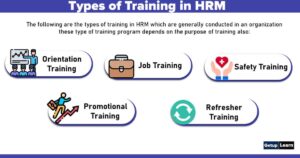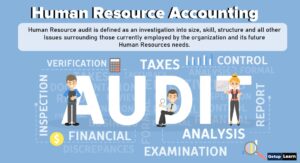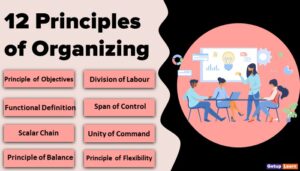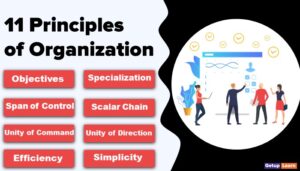Table of Contents
What is Training of Employees?
Training is the creation of an environment where employees may acquire or learn specific, job-related behaviour, knowledge, skills, abilities and attitudes.
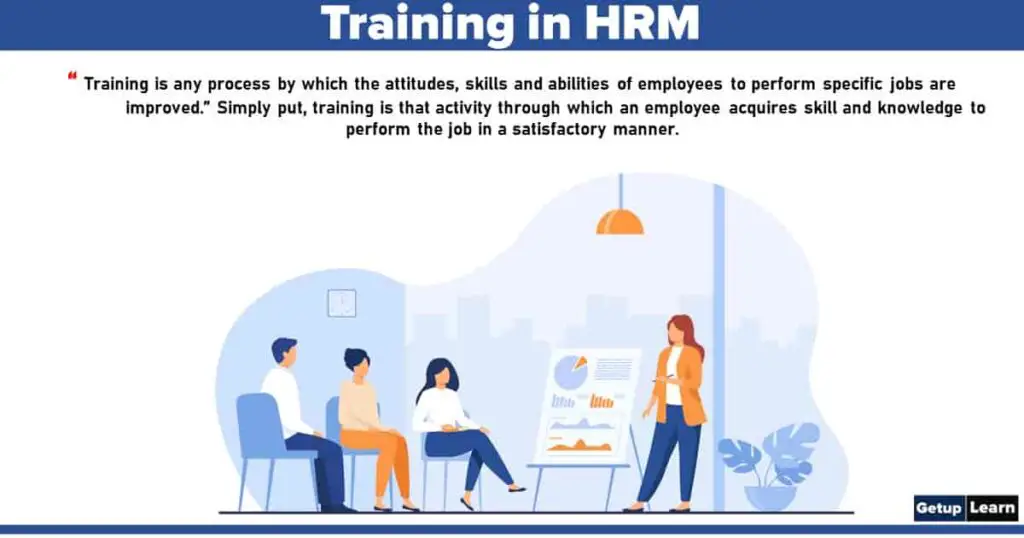
Companies are business entities and in order to survive in the market, profit-making is an essential precondition. The employees are the backbone of the organisation and they possess the skills which help the organisation to attain its goals. Rapidly changing technology results in changes in the production process and thereby in order to attain the goals of the organisation, the skills of the employees have to be upgraded.
Training is an essential activity that is undertaken by the organisation to enhance the skills of the employees by helping them in acquiring new knowledge and skills which are required to perform their present jobs more efficiently. It is usually a short term skills development exercise that is meant for non-managerial employees to learn a job or overcome their deficiency in the performance of a present job.
Previously, organisations did not attach much importance to training activities. But with evolving world, the importance of training has been realized and it is established that in order to achieve the goals of the organisation in a better manner, the skills of employees have to be constantly upgraded.
In order to make any training program successful, it is important that the training needs of the organisation are recognised and then an appropriate training program is designed and implemented to upgrade the knowledge, skills and employee attitude.
Definition of Training in Hrm
Following are the definition of training in hrm:
[su_quote cite=”Edwin Flippo”]Training is the act of increasing the knowledge and skills of an employee for doing a particular job.[/su_quote]
[su_quote cite=”Michael Armstrong”]Training is the formal and systematic modification of behaviour through learning which occurs as a result of education, instruction, development and planned experience.[/su_quote]
[su_quote cite=”Michael Jucious”]Training is any process by which the attitudes, skills and abilities of employees to perform specific jobs are improved.” Simply put, training is that activity through which an employee acquires skill and knowledge to perform the job in a satisfactory manner.[/su_quote]
Importance of Training in Hrm
As training is an activity through which employees acquire skills and knowledge to perform the job in a satisfactory manner, its importance as a tool to acquire organisation goals has been recognised. Moreover, many organisations also use it as a tool to retain employees. Following are the importance of training in hrm:
- Enlarge Skills and Competency
- Effective Use of Current Human Resources
- Increased Customer Satisfaction
- Creation of Competitive Advantage
- Team Spirit
- Ensuring Personal Growth
- Creation of Positive Organisation Climate
- Better Health and Safety Measures Are Ensured
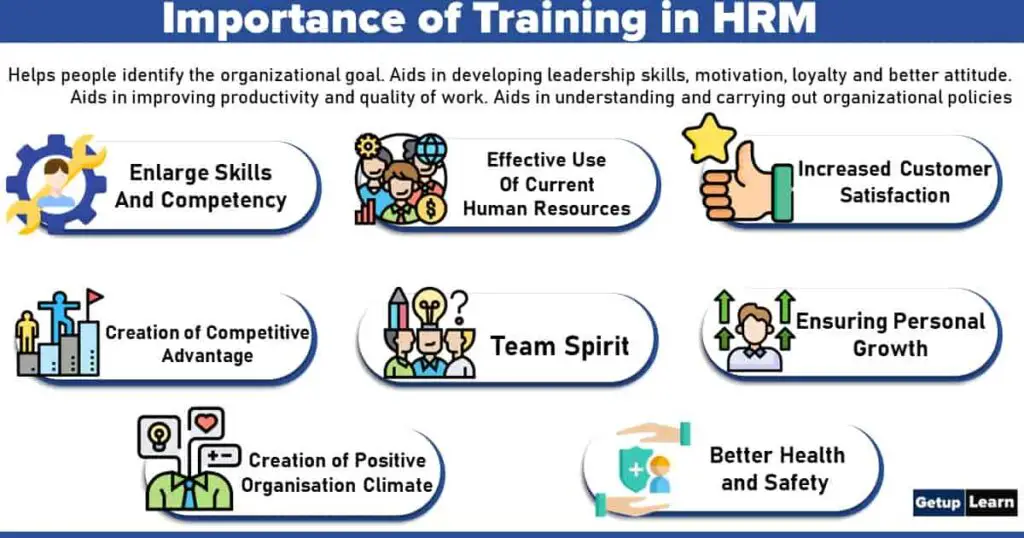
Enlarge Skills and Competency
Training enhances the technical knowledge and skills of the employees. It helps them to learn new skills and enables them to remain updated. Being up-to-date is a necessity in the current world where technology is ever-changing and improving at a rapid pace.
Effective Use of Current Human Resources
Training helps in improving the performance of the existing employees. It also aids the employees in effectively achieving the organisational goals. With the help of training, the skills of employees enhance and they are able to work more efficiently thereby increasing their chances of advancement in careers.
Increased Customer Satisfaction
As the training of employees ensures that the work is undertaken by the employees is done in an efficient manner, the quality of the finished product also improves. Moreover, as the efficiency of the employee’s increases, the defects in the products would be reduced.
As the work is done more efficiently, economies of scale can be achieved whereby the cost of production is reduced which would lead to a lower price of the product at the hand of the end-user. Due to all these factors, customer satisfaction is enhanced.
Creation of Competitive Advantage
Training can be used as a strategic tool by the organisation to retain skilled employees. When the organisation is able to build and retain a workforce that is loyal and capable of meeting any situation, then it can stand its competition in the market and carve out a niche for itself.
Team Spirit
While undergoing training, generally, employees interact with each other without the barriers of the organisational setup. Due to this, friendliness among them increases and a feeling of belonging to a team is created between them. As a result, cooperation increases and the members work hard to succeed as a team.
Ensuring Personal Growth
Through training, employees acquire skills that help in the achievement of organisational goals and also ensure that the employee as an individual also grows. Employees would always prefer to work in organisations where they are trained in new modern technologies and a chance is given to them to upgrade their skills.
Through training programs, not only organisational goals are achieved in a more efficient manner, but the employees are able to enhance their skills which helps them to move ahead in their careers.
Creation of Positive Organisation Climate
Due to training, the interactions between the employees and employer increase and a good labour management relationship is created. Further, it also ensures that the individual, as well as organisational goals, are properly aligned. As a result, a positive climate in the organisation is created.
Better Health and Safety Measures Are Ensured
Many times, training programs are conducted in order to improve the knowledge of safety measures taken in an organisation. As employees get updated knowledge regarding new technologies and production processes, industrial accidents are reduced. As a result, a healthy working environment is ensured.
Training Needs Assessment
Training needs assessment is an important activity and is done at two levels. At the first level, the training needs of individual employees are as- sessed and then at the second stage training needs of the different groups are assessed. For this, a skill inventory of employees is prepared.
This helps the organisation to identify what skills employees possess and which skills are in shortage. The shortage of skills is an indication as to which type of training programs are required to be implemented. For determining the training needs, the organisation should collect information from as many sources as possible and then decide information from which source should be relied on.
The following are the various sources from which the information could be collected. These are the steps of the training needs assessment process:
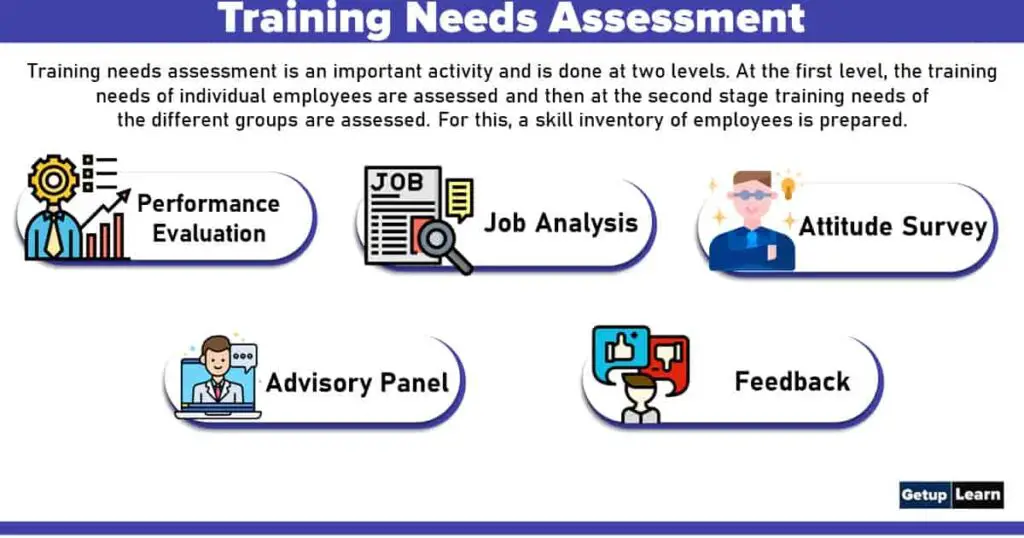
Performance Evaluation
The current performance of an employee is an important indicator of the training requirements. Generally, the employees who perform poorly in performance evaluation are identified for training. The performance of employees could be reviewed through performance scales, absenteeism records and attrition reports. This information provides important inputs which determine the nature, type and extent of training for each employee.
Job Analysis
The job analysis report, which includes a job description report and job specification report can be examined to decide the skills, abilities and knowledge which are required to perform the job effectively. It may form the basis for determining the training requirements of the jobholders.
Attitude Survey
An attitude survey is a process of gathering information from the employees about the various aspects of the organisation. It helps the management to collect information about the attitude of the workers towards their work environment, level of awareness, views on the relevance of existing training programs and on that basis, the future training requirements can be ascertained.
Advisory Panel
An advisory panel that comprises the representatives of management and employees can be formed. The panel has to assess the skill requirement before deciding the number and nature of the training programs required for a specific period.
Feedback
Feedback from various stakeholders helps the management in determining the training needs. The customers can help the management to identify the flaws in the product and how the performance of the employees can be improved. The employees who have quit their jobs can provide vital clues about the weaknesses of the organisation in general and the training programs in particular when they exit their job.
Training Process in HRM
As changes in internal and external situations are unavoidable, training becomes a continuous process. Generally, training prepares the employees to respond to changes in a successful way. The following are the steps that are included in the training process in hrm:
- Determination of Training Needs
- Development of Training Objectives
- Selection of Training Techniques
- Identifying the Trainers
- Implementing Training Program
- Evaluation of Training Program
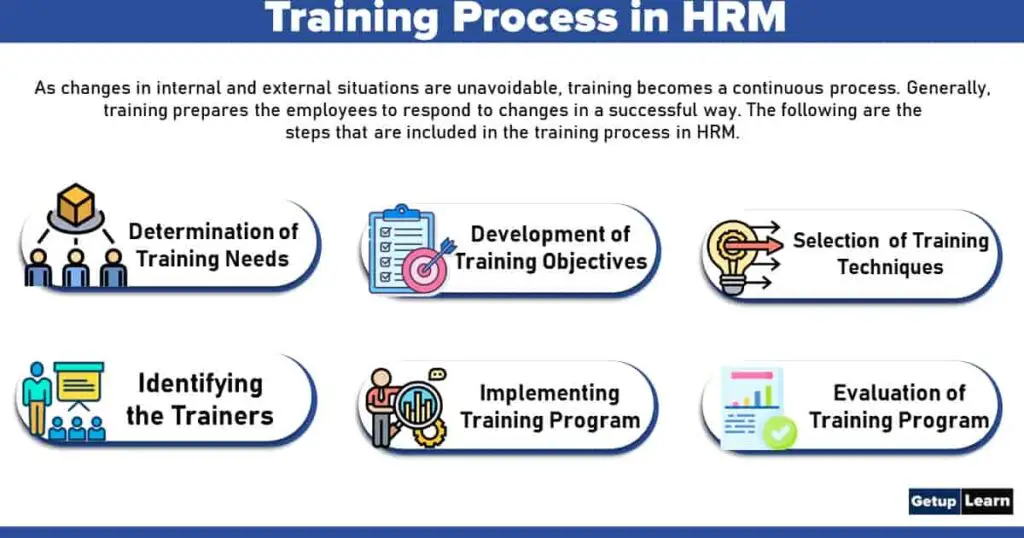
Determination of Training Needs
The first step in any training process is to identify the operational skills which have to be developed for performing a job. For this, the training needs are identified at three levels. In the first stage, the areas where training is needed in the organisation are identified.
The plans and goals are carefully examined and then an inventory of existing manpower is prepared to determine the training needs. Then the operational analysis is undertaken where the work to be performed after training is examined so that how the job can be performed in an effective manner can be determined.
In the third stage, the focus is put on the individual training needs and the difference between the actual performance and standard performance of an individual is undertaken. At this stage, employees are asked about their job knowledge and skills to determine their training needs.
Development of Training Objectives
Once the training goals are established, the next step is to develop the objectives of the training programs. Each training program can have its own objective but it should be related to assessing training needs and should also focus on satisfying those needs. The programs for training should be clear and concise.
Selection of Training Techniques
In order to achieve the training needs and goals, an appropriate training method should be chosen to achieve the desired results. The training method can be broadly classified into two categories namely on-the-job training methods and off-the-job training methods.
On-the-job training methods impart real-time training at a work spot while off-the-job training involves training at a place away from a work spot in a for- mal classroom.
Identifying the Trainers
Once the training method has been decided, the next crucial step is selecting and training the trainers for the program. It is a critical step as the success of the training program depends on the ability of the trainers. The trainers should be competent, knowledgeable and mature people who have effective communication skills.
They should be familiar with the philosophy of the company, objectives, structure, culture and specific purposes of the training program.
Implementing Training Program
Once the method of training and trainer is decided, the actual training program is to be implemented. For implementing the training program successfully, the location, training facilities, quality and adequacy of materials, timing and duration of the program have to be considered. Similarly, the interaction between trainers and trainees has also to be considered.
It should also be ensured that the training programs should not clash with the full-time duties of the employees by fixing the training schedule in such a manner. Moreover, proper records of employee performance should be maintained before and after the training program to determine the gains of the employees achieved by them through the training program.
Evaluation of Training Program
This is the final step of the training process. In order to evaluate the performance in an effective manner, the attributes such as knowledge, skills and attitude of employees have to be evaluated. Once the training is completed, an evaluation of these attributes has to be undertaken for determining if the training program is effective or not.
For enabling evaluation, proper documentation has to be maintained which would demonstrate the addition of the training program.
Types of Training in HRM
The following are the types of training in hrm which are generally conducted in an organisation these type of training program depends on the purpose of training also:
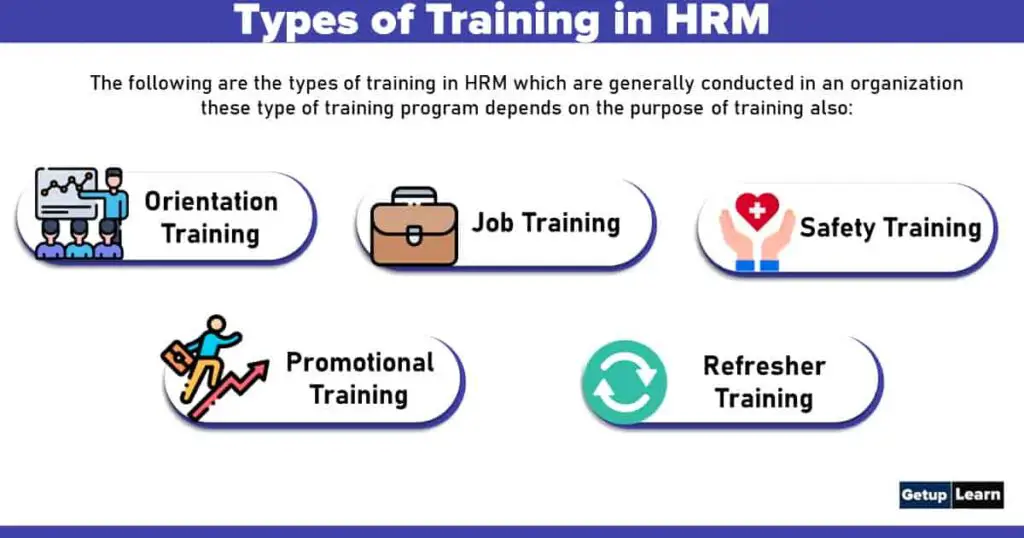
Orientation Training
Induction orientation training seeks to adjust newly appointed employees to the work environment. Every new employee needs to be made fully, familiar with his job, his superiors and subordinates and with the rules and regulations of the organizations. Induction training create self-confidence in the employees. It is also known as pre-job training.
Job Training
It refers to the training provided with a view to increase the knowledge and skills of an employee for a particular job. Employees may be taught in the techniques and machines used in a job. Such training helps to reduce waste and inefficiency in the performance of the job.
Safety Training
Training provided to minimise accidents and damage to machinery is known as safety training. It involves instruction in the use of safety devices and in safety consciousness.
Promotional Training
It involves training of existing employees to enable them to perform higher level jobs. Employees with potential are selected and they are given training before their promotion.
Refresher Training
When existing techniques become obsolete due to the development of better techniques, employees have to be trained in the use of new methods and techniques. Such training is designed to refresh the knowledge and to update the skills of the employees. Short- term refresher courses have become popular on account of rapid changes in science and technology.
What is the concept of training?
Training of employees takes place after orientation takes place. Training is the process of enhancing the skills, capabilities and knowledge of employees for doing a particular job. Training process moulds the thinking of employees and leads to quality performance of employees. It is continuous and never ending in nature.
What is meant by training?
Training is a process of learning a sequence of programmed behavior. It is the application of knowledge & gives people an awareness of rules & procedures to guide their behavior. It helps in bringing about positive change in the knowledge, skills & attitudes of employees.
What are the four importance of training?
Following are four main importance of trainin in HRM:
1. Enlarge Skills and Competency
2. Effective Use of Current Human Resources
3. Increased Customer Satisfaction
4. Creation of Competitive Advantage
5. Team Spirit
6. Ensuring Personal Growth
7. Creation of Positive Organisation Climate
8. Better Health and Safety Measures Are Ensured etc.
What are the three different types of training needs assessment?
These are the three different types of training needs assessment: 1. Performance Evaluation, 2. Job Analysis, 3. Attitude Survey, 4. Advisory Panel, 5. Feedback etc.
What are the steps in the training process?
The following are the steps that are included in the training process in hrm:
1. Determination of Training Needs
2. Development of Training Objectives
3. Selection of Training Techniques
4. Identifying the Trainers
5. Implementing Training Program
6. Evaluation of Training Program etc.


